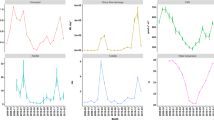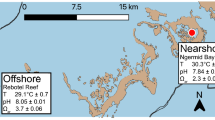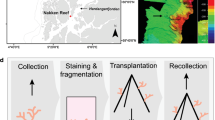Abstract
The long-distance dispersal of larvae provides important linkages between populations of reef-building corals and is a critical part of coral biology. Some coral planulae have symbiotic dinoflagellates (Symbiodinium spp.) that probably provide energy in addition to the lipids provisioned within the egg. However, our understanding of the influence of symbionts on the energy metabolism and survivorship of planulae remains limited. This study examines the relative roles of symbiotic dinoflagellate photosynthesis and stored lipid content in the survivorship of the developing stages of the corals Pocillopora damicornis and Montipora digitata. We found that survivorship decreased under dark conditions (i.e. no photosynthetic activity) for P. damicornis and M. digitata at 31 and 22 days after release/spawning, respectively. The lipid content of P. damicornis and M. digitata planulae showed a significant decrease, at a higher rate, under dark conditions, when compared with light conditions. When converted to energy equivalents, the available energy provided by the depletion of lipids could account for 41.9 and 84.7% of larval metabolism for P. damicornis (by day 31) and 38.4 and 90.1% for M. digitata (by day 21) under light and dark conditions, respectively. This finding indicates that not all energy requirements of the larvae are met by lipids: energy is also sourced from the photosynthetic activities of the symbiotic dinoflagellates within these larvae, especially under light conditions. In addition, the amounts of three main lipid classes (wax esters, triglycerides, and phospholipids) decreased throughout the experiment in the planulae of both species, with the wax ester content decreasing more rapidly under dark conditions than under light conditions. The observations that the planulae of both species derive considerable amounts of energy from wax esters, and that symbiotic dinoflagellates enable larvae to use their stores at lower rates, suggested that symbiotic dinoflagellates have the potential to extend larval life under light conditions.





Similar content being viewed by others
References
Adams LM, Cumbo VR, Takabayashi M (2009) Exposure to sediment enhances primary acquisition of Symbiodinium by asymbiotic coral larvae. Mar Ecol Prog Ser 377:149–156. doi:10.3354/meps07834
Alamaru A, Yam R, Shemesh A, Loya Y (2009) Trophic biology of Stylophora pistillata larvae: evidence from stable isotope analysis. Mar Ecol Prog Ser 383:85–94. doi: 10.3354/meps07958
Anthony KRN, Kerswell AP (2007) Coral mortality following extreme low tides and high solar radiation. Mar Biol 151:1623–1631
Arai T, Kato M, Heyward A, Ikeda Y, Iizuka T, Maruyama T (1993) Lipid-composition of positively buoyant eggs of reef building corals. Coral Reefs 12:71–75
Atoda K (1947) The larval and postlarval development of some reef-building corals. I. Pocillopora damicornis cespitosa. Sci Rep Tohoku Univ Ser 4:25–47
Baird AH, Gilmour JP, Kamiki TM, Nonaka M, Pratchett MS, Yamamoto HH, Yamasaki H (2006) Temperature tolerance of symbiotic and non-symbiotic coral larvae. Proc Int Coral Reef Symp 1:38–42
Ben-David-Zaslow R, Benayahu Y (2000) Biochemical composition, metabolism, and amino acid transport in planula-larvae of the soft coral Heteroxenia fuscescens. J Exp Zool 287:401–412
Cox DR (1972) Regression models and life tables. J Royal Stat Soc 34:187–220
Crossland CJ, Barns DJ, Borowitzka MA (1980) Diurnal lipid and mucus production in the staghone coral Acropora acuminata. Mar Biol 60:81–90
Edmunds PJ, Gates RD, Gleason DF (2001) The biology of larvae from the reef coral Porites astreoides, and their response to temperature disturbances. Mar Biol 139:981–989
Fitt WK, Trench R (1981) Spawning, development, and acquisition of zoozanthellae by Tridacna squamosa (Mollusca, Bivalvia). Biol Bull 161:213–235
Fitt WK, Fisher CR, Trench R (1986) Contribution of the symbiotic dinoflagellate Symbiodinium microadriaticum to the nutrition, growth and survival of larval and juvenile tridacnid clams. Aquaculture 55:5–22
Gnaiger E (1983) Calculation of energetic and biochemical equivalents of respiratory oxygen consumption. In: Gnaiger E, Forstner H (eds) Polarographic oxygen sensors: aquatic and physiological applications. Springer, Berlin, pp 337–345
Graham EM, Baird AH, Connolly SR (2008) Survival dynamics of scleractinian coral larvae and implications for dispersal. Coral Reefs 27:529–539
Harii S, Kayanne H (2003) Larval dispersal, recruitment, and adult distribution of the brooding stony octocoral Heliopora coerulea on Ishigaki Island, southwest Japan. Coral Reefs 22:188–196
Harii S, Kayanne H, Takigawa H, Hayashibara T, Yamamoto M (2002) Larval survivorship, competency periods and settlement of two brooding corals, Heliopora coerulea and Pocillopora damicornis. Mar Biol 141:39–46
Harii S, Nadaoka K, Yamamoto M, Iwao K (2007) Temporal changes in settlement, lipid content and lipid composition of larvae of the spawning hermatypic coral Acropora tenuis. Mar Ecol Prog Ser 346:89–96. doi:10.3354/meps07114
Harii S, Yasuda N, Rodriguez-Lanetty M, Irie T, Hidaka M (2009) Onset of symbiosis and distribution patterns of symbiotic dinoflagellates in the larvae of scleractinian corals. Mar Biol 156:1203–1212. doi:10.1007/s00227-009-1162-9
Harrison PL, Wallace CC (1990) Reproduction, dispersal and recruitment of scleractinian corals. In: Dubinsky Z (ed) Ecosystems of the world 25. Elsevier, Amsterdam, pp 133–207
Heyward AJ, Collins JD (1985) Growth and sexual reproduction in the scleractinian coral Montipora digitata (Dana). Aust J Mar Freshw Res 36:441–446
Heyward AJ, Negri AP (1999) Natural inducers for coral larval metamorphosis. Coral Reefs 18:273–279
Isomura N, Nishihira M (2001) Size variation of planulae and its effect on the lifetime of planulae in three pocilloporid corals. Coral Reefs 20:309–315
Iwao K, Fujisawa T, Hatta M (2002) A cnidarian neuropeptide of the GLWamide family induces metamorphosis of reef-building corals in the genus Acropora. Coral Reefs 21:127–129
Jaeckle WB, Manahan DT (1989) Feeding by a nonfeeding larva—uptake of dissolved amino-acids from seawater by lecithotrophic larvae of the gastropod Haliotis rufescens. Mar Biol 103:87–94
Jones GP, Milicich MJ, Emslie MJ, Lunow C (1999) Self-recruitment in a coral reef fish population. Nature 402:802–804
Lee RF, Hirota J, Barnett AM (1971) Distribution and importance of wax esters in marine copepods and other zooplankton. Deep-Sea Res 18:1147–1165
Lee RF, Hagen W, Kattner G (2006) Lipid storage in marine zooplankton. Mar Ecol Prog Ser 307:273–306
Marsh AG, Leong PKK, Manahan DT (1999) Energy metabolism during embryonic development and larval growth of an Antarctic sea urchin. J Exp Biol 202:2041–2050
Marsh AG, Mullineaux LS, Young CM, Manahan DT (2001) Larval dispersal potential of the tubeworm Riftia pachyptila at deep-sea hydrothermal vents. Nature 411:77–80
Moran AL, Manahan DT (2003) Energy metabolism during larval development of green and white abalone, Haliotis fulgens and H. sorenseni. Biol Bull 204:270–277
Moran AL, Manahan DT (2004) Physiological recovery from prolonged ‘starvation’ in larvae of the Pacific oyster Crassostrea gigas. J Exp Mar Biol Ecol 306:17–36
Morgan SG (1995) The timing of larval release. In: McEdward L (ed) Ecology of marine invertebrate larvae. CRC Press, Boca Raton, pp 249–278
Muscatine L (1990) The role of symbiotic algae in carbon and energy flux in reef corals. In: Dubinsky Z (ed) Ecosystems of the world 25. Elsevier, Amsterdam, pp 5–87
Nevenzel JC (1970) Occurrence, function and biosynthesis of wax esters in marine organisms. Lipids 5:308–319
Nozawa Y, Harrison PL (2005) Temporal settlement patterns of larvae of the broadcast spawning reef coral Favites chinensis and the broadcast spawning and brooding reef coral Goniastrea aspera from Okinawa, Japan. Coral Reefs 24:274–282. doi:10.1007/s00338-005-0476-4
Okubo N, Yamamoto HH, Nakaya F, Okaji K (2008) Oxygen consumption of a single embryo/planula in the reef-building coral Acropora intermedia. Mar Ecol Prog Ser 366:305–309
Patton JS, Burris JE (1983) Lipid synthesis and extrusion by freshly isolated zooxanthellae (symbiotic algae). Mar Biol 75:131–136
Richmond RH (1981) Energetic consideration in the dispersal of Pocillopora damicornis (Linnaeus) planulae. Proc 4th Inter Coral Reef Symp 2:153–156
Richmond RH (1985) Reversible metamorphosis in coral planula larvae. Mar Ecol Prog Ser 22:181–185
Richmond RH (1987) Energetics, competence, and long-distance dispersal of planula larvae of the coral Pocillopora damicornis. Mar Biol 93:527–533
Richmond R, Hunter CL (1990) Reproduction and recruitment of corals: comparisons among the Caribbean, the Tropical Pacific, and the Red Sea. Mar Ecol Prog Ser 60:185–203
Roberts CM (1997) Connectivity and management of Caribbean coral reefs. Science 278:1454–1457
Rodriguez-Lanetty M, Krupp DA, Weis VM (2004) Distinct ITS types of Symbiodinium in Clade C correlate with cnidarian/dinoflagellate specificity during onset of symbiosis. Mar Ecol Prog Ser 275:97–102
Schwarz JA, Krupp DA, Weis VM (1999) Late larval development and onset of symbiosis in the scleractinian coral Fungia scutaria. Biol Bull 196:70–79
Sewell MA (2005) Utilization of lipids during early development of the sea urchin Evechinus chloroticus. Mar Ecol Prog Ser 304:133–142
Shanks AL (1995) Mechanisms of cross-shelf dispersal of larval invertebrates and fish. In: McEdward LR (ed) Ecology of the marine invertebrate larvae. CRC Press, Boca Raton, pp 323–367
Shanks AL (2009) Pelagic larval duration and dispersal distance revisited. Biol Bull 216:373–385
Shilling FM, HoeghGuldberg O, Manahan DT (1996) Sources of energy for increased metabolic demand during metamorphosis of the abalone Haliotis rufescens (Mollusca). Biol Bull 191:402–412
Szmant AM, Meadows MG (2006) Developmental changes in coral larval buoyancy and vertical swimming behavior: implications for dispersal and connectivity. Proc 10th Int Coral Reef Symp 1:431–437
Tanaka Y, Miyajima T, Koike I, Hayashibara T, Ogawa H (2007) Imbalanced coral growth between organic tissue and carbonate skeleton caused by nutrient enrichment. Limnol Oceanogr 52:1139–1146
Thorson G (1950) Reproductive and larval ecology of marine bottom invertebrates. Biol Rev 25:1–45
Underwood AJ (1981) Technique of analysis of variance in experimental marine biology and ecology. Oceanogr Mar Biol Ann Rev 19:513–605
Vavra J, Manahan DT (1999) Protein metabolism in lecithotrophic larvae (Gastropoda: Haliotis rufescens). Biological Bull 196:177–186
Villinski JT, Villinski JC, Byrne M, Raff RA (2002) Convergent maternal provisioning and life-history evolution in echinoderms. Evolution 56:1764–1775
Weis VM, Reynolds WS, deBoer MD, Krupp DA (2001) Host-symbiont specificity during onset of symbiosis between the dinoflagellates Symbiodinium spp and planula larvae of the scleractinian coral. Coral Reefs 20:301–308
Wellington GM, Fitt WK (2003) Influence of UV radiation on the survival of larvae from broadcast-spawning reef corals. Mar Biol 143:1185–1192
Yamamoto M, Shiraiwa Y, Inouye I (2000) Physiological responses of lipids in Emiliania huxleyi and Gephyrocapsa oceanica (Haptophyceae) to growth status and their implications for alkenone paleothermometry. Org Geochem 31:799–811
Yokohama Y, Katayama N, Furuya K (1986) An improved type of ‘product meter’, a differential gas-volumeter, and its application to measuring photosynthesis of seaweeds. Japan J Phycol 37–42 (in Japanese with English abstract)
Young CM (1995) Behavior and locomotion during the dispersal phase of larval life. In: McEdward L (ed) Ecology of marine invertebrate larvae. CRC Press, Boca Raton, pp 249–278
Acknowledgments
We are most grateful to the staff of the Heron Island Research Station and to the field and laboratory assistance of Eugenia Sampayo, Joanne Davy and Ayax R. Díaz-Ruíz from the University of Queensland. Hroo Satoh from Tokyo University of Marine Science and Technology provided the laboratory equipment. We thank the Ove Hoegh-Guldberg lab members, the University of Queensland and Frederic Sinniger, University of the Ryukyus for discussions. We are also grateful for the valuable comments made by three anonymous reviewers, which have helped to improve this manuscript. The research was funded by an Australian Research Council grant to OHG and the Japan Society for the Promotion of Science (JSPS) for research abroad to SH.
Author information
Authors and Affiliations
Corresponding author
Additional information
Communicated by M. Kühl.
Rights and permissions
About this article
Cite this article
Harii, S., Yamamoto, M. & Hoegh-Guldberg, O. The relative contribution of dinoflagellate photosynthesis and stored lipids to the survivorship of symbiotic larvae of the reef-building corals. Mar Biol 157, 1215–1224 (2010). https://doi.org/10.1007/s00227-010-1401-0
Received:
Accepted:
Published:
Issue Date:
DOI: https://doi.org/10.1007/s00227-010-1401-0




